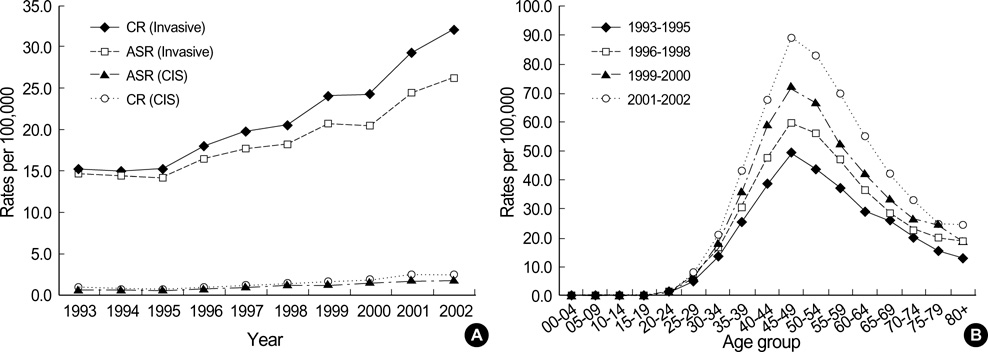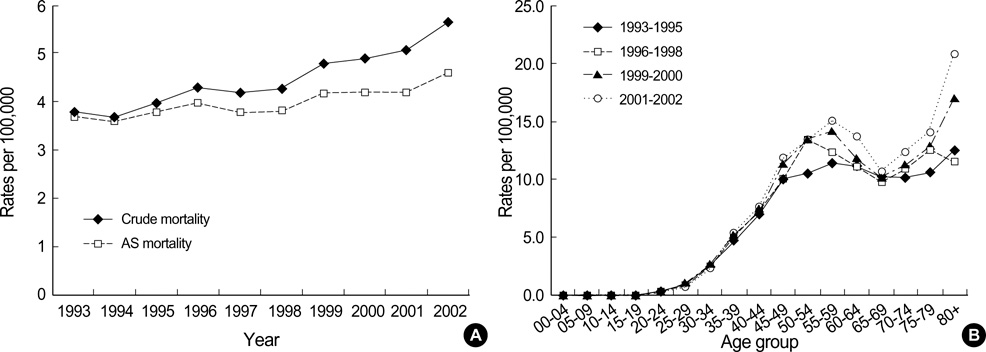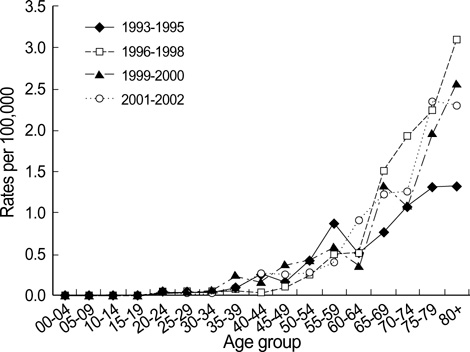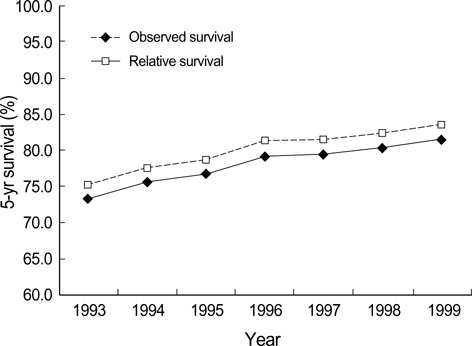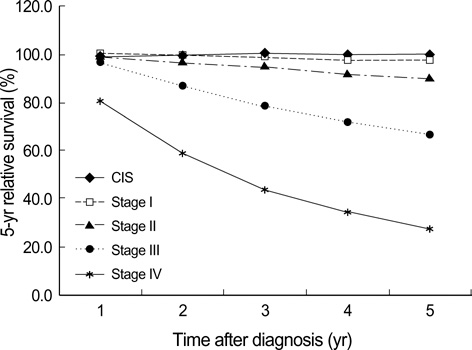Population-based Breast Cancer Statistics in Korea during 1993-2002: Incidence, Mortality, and Survival
- Affiliations
-
- 1Korea Central Cancer Registry, National Cancer Center, Goyang, Korea. hrshin@ncc.re.kr
- 2Department of Surgery, College of Medicine, University of Ulsan, Asan Medical Center, Seoul, Korea. anhsh@amc.seoul.kr
- 3Department of Surgery, Yonsei University College of Medicine, Yongdong Severance Hospital, Seoul, Korea.
- 4Center for Breast Cancer, Goyang, Korea.
- 5The Korean Breast Cancer Society, Seoul, Korea.
- KMID: 1785783
- DOI: http://doi.org/10.3346/jkms.2007.22.S.S11
Abstract
- In 2002, breast became the most common cancer site in Korean women. Using national breast cancer incidence data during 1993-2002, crude, age-standardized, and age-specific rates for incidence and mortality were calculated. Survival was examined for cases diagnosed during 1993-2002 and followed up to 2004. Observed survival was calculated using the life table method and relative survival using the Ederer II method. Age-standardized incidence rates in female increased from 14.5 in 1993 to 26.2 per 100,000 in 2002. Age-specific incidences showed peaks in women in their forties. Mortality rates increased from 3.7 in 1993 to 4.6 per 100,000 in 2002 and showed peaks in women in their fifties. Five-year relative survival for female breast cancer diagnosed during 1993-2002 was 82.2%. When we examined the secular trends using cases diagnosed 1993-1999 for complete 5-yr follow-up, the 5-yr relative survival increased from 75.2% in 1993 to 83.5% in 1999. The data from this study will provide valuable information to plan and evaluate actions against breast cancer including national breast cancer screening.
Keyword
MeSH Terms
Figure
Cited by 9 articles
-
Long-Term Survival Analysis of Korean Breast Cancer Patients at a Single Center: Improving Outcome Over Time
Sung Gwe Ahn, Hak Min Lee, Seung Ah Lee, Joon Jeong, Hy-De Lee
Yonsei Med J. 2014;55(5):1187-1195. doi: 10.3349/ymj.2014.55.5.1187.Breast Cancer Screening: A Medical Audit of the Screening Mammography Performed at One Institution for 10 Years
Min Hee Hur, Hae Kyung Lee, Wan Nam Kang, Chan Seok Yoon, Seung Sang Ko, Yu-Jin Lee, Kyung Sang Lee, Byung Jae Cho, Sung Soo Kang
J Breast Cancer. 2008;11(4):180-186. doi: 10.4048/jbc.2008.11.4.180.Prognostic Significance of Basal Markers in Triple-negative Breast Cancers
Jun Mo Kim, Tae Yoon Hwang, Su Hwan Kang, Soo Jung Lee, Young Kyung Bae
J Breast Cancer. 2009;12(1):4-13. doi: 10.4048/jbc.2009.12.1.4.Risk Factors and Control Strategies for the Rapidly Rising Rate of Breast Cancer in Korea
Sue K. Park, Yeonju Kim, Daehee Kang, En-Joo Jung, Keun-Young Yoo
J Breast Cancer. 2011;14(2):79-87. doi: 10.4048/jbc.2011.14.2.79.Stem Cell Implants for Cancer Therapy: TRAIL-Expressing Mesenchymal Stem Cells Target Cancer Cells In Situ
Michaela R. Reagan, F. Philipp Seib, Douglas W. McMillin, Elizabeth K. Sage, Constantine S. Mitsiades, Sam M. Janes, Irene M. Ghobrial, David L. Kaplan
J Breast Cancer. 2012;15(3):273-282. doi: 10.4048/jbc.2012.15.3.273.Adjuvant Chemotherapy and Survival of Elderly Korean Patients with Breast Carcinoma
Seung Pil Jung, Jeong Eon Lee, Se Kyung Lee, Sangmin Kim, Min-Young Choi, Soo Youn Bae, Jiyoung Kim, Won Ho Kil, Jun-Ho Choe, Jung-Han Kim, Jee Soo Kim, Seok Jin Nam
J Breast Cancer. 2012;15(3):296-305. doi: 10.4048/jbc.2012.15.3.296.Chemotherapy-Induced Left Ventricular Dysfunction in Patients with Breast Cancer
Hyun Ju Yoon, Kye Hun Kim, Jong Yoon Kim, Hyuk Jin Park, Jae Yeong Cho, Young Joon Hong, Hyung Wook Park, Ju Han Kim, Youngkeun Ahn, Myung Ho Jeong, Jeong Gwan Cho, Jong Chun Park
J Breast Cancer. 2016;19(4):402-409. doi: 10.4048/jbc.2016.19.4.402.Epidemiologic Characteristics of the Breast Cancer in Korea
Sue K Park, Daehee Kang, Yeonju Kim, Keun-Young Yoo
J Korean Med Assoc. 2009;52(10):937-945. doi: 10.5124/jkma.2009.52.10.937.Trends of Mammography Use in a National Breast Cancer Screening Program, 2004-2008
Sun Mi Lim, Hoo-Yeon Lee, Kui Son Choi, Jae Kwan Jun, Eun-Cheol Park, Yeonju Kim, Mi Ah Han, Dong Kwan Oh, Jung Im Shim
Cancer Res Treat. 2010;42(4):199-202. doi: 10.4143/crt.2010.42.4.199.
Reference
-
1. Parkin DM, Bray F, Ferlay J, Pisani P. Global cancer statistics, 2002. CA Cancer J Clin. 2005. 55:74–108.
Article2. Shin HR, Won YJ, Jung KW, Kong HJ, Yim SH, Lee JK, Noh HI, Pisani P, Park JG, Ahn YO, Lee SY, Lee CW, Woo ZH, Lee TY, Choi JS, Yoo CI, Bae JM. Nationwide cancer incidence in Korea, 1999-2001; first result using the National Cancer Incidence Database. Cancer Res Treat. 2005. 37:325–331.
Article3. Shin HR, Jung KW, Won YJ, Park JG. 139 KCCR-affiliated Hospitals. 2002 Annual report of the Korea Central Cancer Registry: Based on registered data from 139 hospitals. Cancer Res Treat. 2004. 36:103–114.
Article4. Korean Breast Cancer Society. Clinical characteristics of Korean breast cancer patients in 1998. J Korean Med Sci. 2000. 15:569–579.5. National Statistical Office. 2006. Accessed 7 September 2006. Available at http://kosis.nso.go.kr.6. Segi M. Cancer Mortality for selected sites in 24 countries (1950-1957). 1960. Sendai, Japan: Tohuku University of Medicine.7. Ries L, Harkins D, Krapcho M, Mariotto A, Miller B, Feuer E, Clegg L, Eisner M, Horner M, Howlader N, Hayat M, Hankey B, Edwards B. SEER Cancer Statistics Review, 1975-2003. Accessed 12 September 2006. Bethesda MD: National Cancer Institute;Available at http://seer.cancer.gov/csr/1975_2003/. based on November 2005 SEER data submission, posted to the SEER web site, 2006.8. Sankaranarayanan R, Black RJ, Swaminathan R, Parkin DM. An overview of cancer survival in developing countries. IARC Sci Publ. 1998. 145:135–173.9. American Joint Committee on Cancer. AJCC Cancer staging manual. 1997. 5th ed. Philadelphia, USA: Lippincott-Raven.10. Ederer F, Heise H. Instructions to IBM programmers in processing survival computations. methodological note No.10. 1959. Bethesda MD: National Cancer Institute.11. Dickman P. Accessed 6 September 2006. Available at http//www.pauldickman.com.12. MacMahon B. Epidemiology and the causes of breast cancer. Int J Cancer. 2006. 118:2373–2378.
Article13. Parkin DM, Whelan SL, Ferlay J, Storm H. Cancer incidence in five continents. 2002. vol VIII. Lyon, France: IARC.14. Botha JL, Bray F, Sankila R, Parkin DM. Breast cancer incidence and mortality trends in 16 European countries. Eur J Cancer. 2003. 39:1718–1729.
Article15. Korean Breast Cancer Society. Nationwide Korean breast cancer data of 2002. J Korean Breast Cancer Soc. 2004. 7:72–83.16. Yoo KY, Kang D, Park SK, Kim SU, Kim SU, Shin A, Yoon H, Ahn SH, Noh DY, Choe KJ. Epidemiology of breast cancer in Korea: occurrence, high-risk groups, and prevention. J Korean Med Sci. 2002. 17:1–6.
Article17. Bae JM, Won YJ, Jung KW, Suh KA, Yun YH, Shin MH, Ahn YO, Lee DH, Shin HR, Ahn DH, Oh DK, Park JG. 134 KCCR-affiliated Hospitals. Survival of Korean Cancer Patients Diagnosed in 1995. Cancer Res Treat. 2002. 34:319–325.
Article18. Sankaranarayanan R, Swaminathan R, Brenner H. Cancer survival in developing countries: an overview. 2006. Union Internationale Contre le Cancer (UICC) World Cancer Congress.19. Coleman MP, Gatta G, Verdecchia A, Estéve J, Sant M, Storm H, Allemani C, Ciccolallo L, Santaquilani M, Berrino F. EUROCARE Working Group. EUROCARE-3 summary: cancer survival in Europe at the end of the 20th century. Ann Oncol. 2003. 14:Suppl 5. v128–v149.
Article20. Nomura K, Sobue T, Nakatani H, Maehara M, Kiryu Y, Tsukuma H, Doi M. Cancer statistics in Japan 2005. 2005. Tokyo, Japan: Foundation for Promotion of Cancer Research.21. Sant M, Allemani C, Berrino F, Coleman MP, Aareleid T, Chaplain G, Coebergh JW, Colonna M, Crosignani P, Danzon A, Federico M, Gafà L, Grosclaude P, Hédelin G, Macè-Lesech J, Garcia CM, Møller H, Paci E, Raverdy N, Tretarre B, Williams EM. European Concerted Action on Survival and Care of Cancer Patients (EUROCARE) Working Group. Breast carcinoma survival in Europe and the United States. Cancer. 2004. 100:715–722.
Article22. Parkin DM, Chen VW, Ferlay J, Galceran J. Comparability and Quality Control in Cancer Registration. 1994. Lyon: IARC.23. Lee DH, Shin HR, Ahn DH, Chun BY, Kam Sin, Ahn YO. Accuraey of Cancer Death Certificates in KOREA: A comparison between diagnoses in the central cancer registry and certified underlying causes of death. J Korean Cancer Assoc. 2000. 32:210–219.24. Ministry of Health and Welfare. 2005 Annual report on the cause of death statistics (based on vital registration). 2006.
- Full Text Links
- Actions
-
Cited
- CITED
-
- Close
- Share
- Similar articles
-
- Cancer Statistics in Korea: Incidence, Mortality, Survival and Prevalence in 2010
- Cancer Statistics in Korea: Incidence, Mortality, Survival, and Prevalence in 2012
- Cancer Statistics in Korea: Incidence, Mortality, Survival, and Prevalence in 2011
- Cancer Statistics in Korea: Incidence, Mortality, Survival, and Prevalence in 2014
- Cancer Statistics in Korea: Incidence, Mortality, Survival, and Prevalence in 2009

